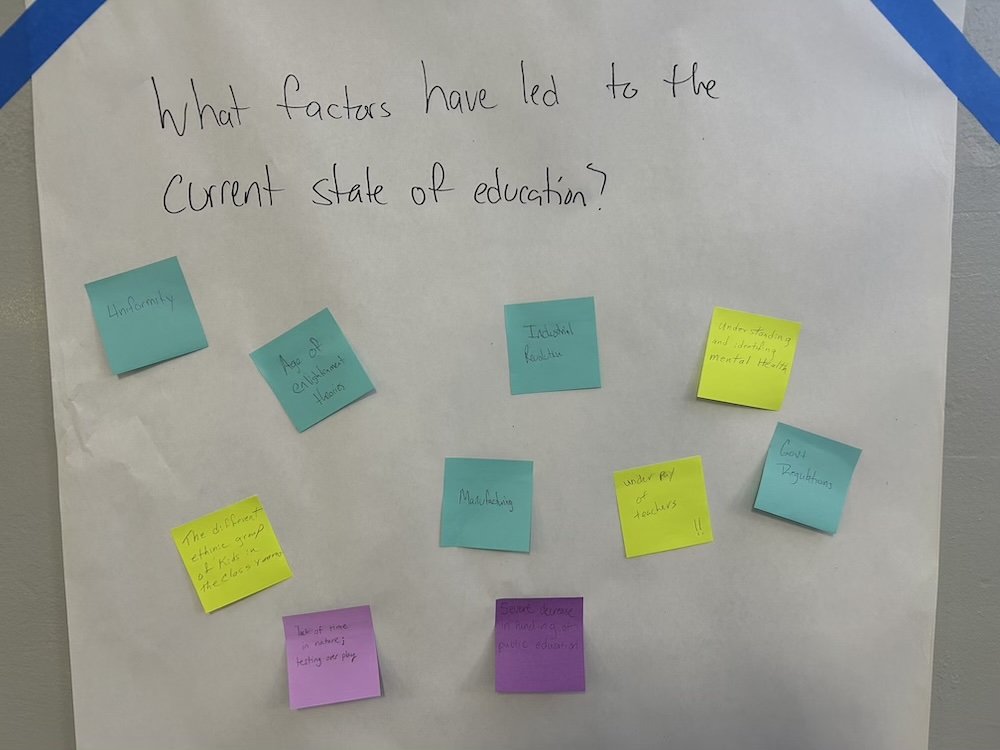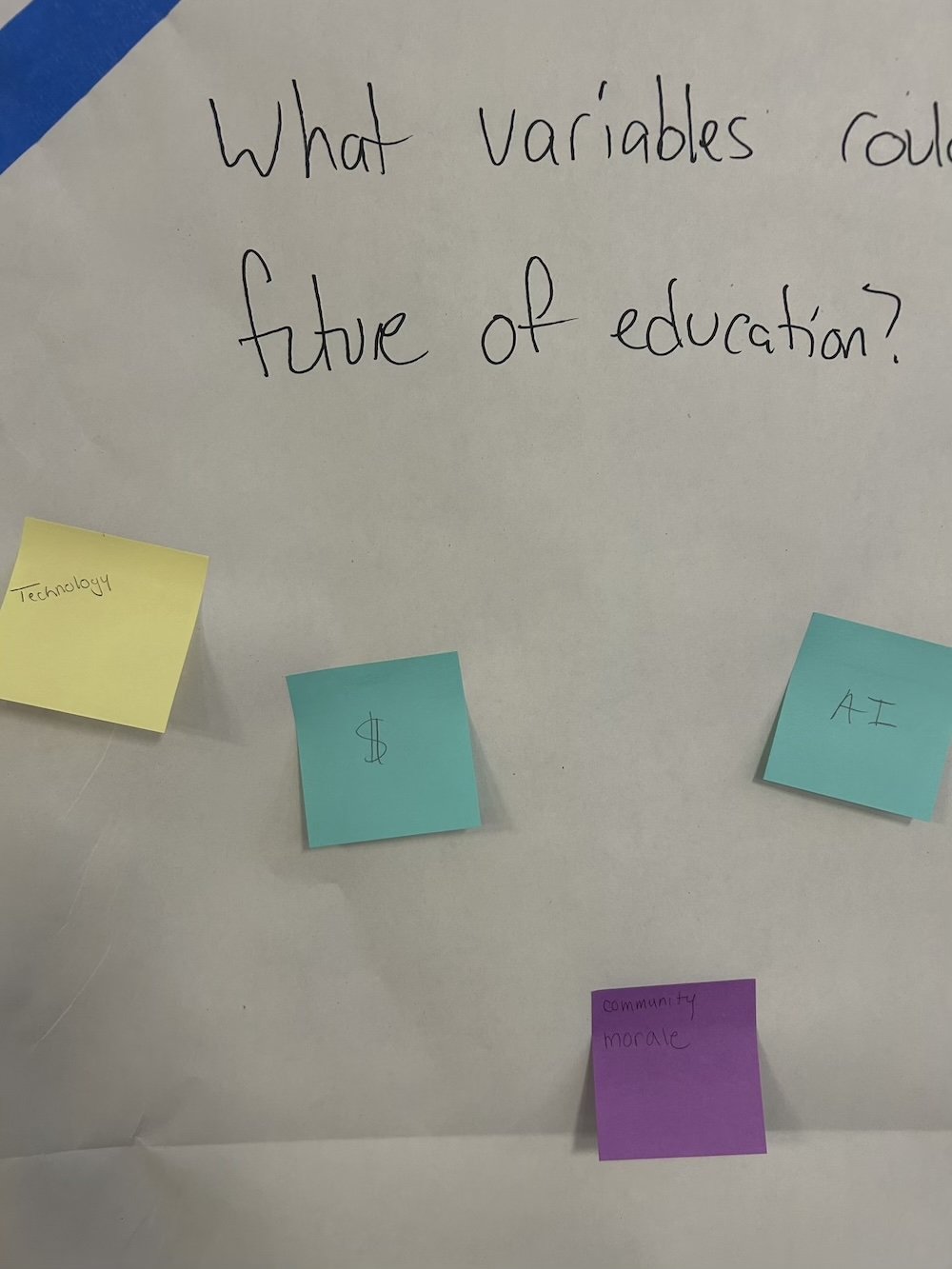Quality of Life Forum: Education Recap
Hopes for the Next 20 Years in Education:
Outdoor Schools: The desire for more outdoor education experiences.
Project-Based Learning: A shift towards project-based learning methods.
Reskilling Adults: Increased emphasis on retraining and upskilling adults.
Changing the Narrative for Teachers: A call to change how society perceives and values the work of teachers.
Different Learning Approach: A vision of education looking entirely different.
Free Preschool Access: Expanding access to free preschool for more children.
Lifelong Learning: Viewing learning as a lifelong journey from birth to death.
Individualized Learning: Personalized learning experiences.
Eliminating Standardized Statewide Assessments: Advocating for the removal of standardized assessments.
Variables Impacting the Future of Education:
Technology: Technological advancements.
Money and Funding: Financial resources and funding.
AI (Artificial Intelligence): The influence of AI on education.
People: The role of individuals in shaping education.
Density: Population density and its impact on education.
Factors Leading to the Current State of Education:
Uniformity: The historical focus on uniform education.
Age of Enlightenment Theories: Historical educational theories.
Industrial Revolution: The impact of the Industrial Revolution on education.
Mental Health Awareness: Recognizing and addressing mental health in schools.
Diversity in Classrooms: Dealing with diverse ethnic groups in classrooms.
Manufacturing: The influence of manufacturing on education.
Teacher Pay: The issue of underpaid teachers.
Government Regulations: Government policies and regulations.
Lack of Nature Time: Insufficient time spent in nature.
Testing Over Play: Overemphasis on testing over play-based learning.
Decreased Funding: A significant decrease in public education funding.
Undiscussed Topics in Education:
Early Child Development: The importance of early childhood development.
Future Workforce Needs: Preparing students for future workforce demands.
School Boards Disconnect: Disconnect between school boards and the majority and minority populations.
Teacher Mental Health: Addressing the mental health of teachers.
Restraint and Seclusion: Concerns about the use of restraint and seclusion, especially with disabled students, BIPOC, and low-income students.
Home Life Impact: Considering the impact of students' home lives.
Decreased Movement: Recognizing the effects of decreased physical activity on learning.
Opportunities for the Future of Education:
Rewilding: Incorporating nature-based education (rewilding).
Ecological Changes: Adapting education to ecological shifts.
Transformation: The potential for transformative changes in education.
Local Education: Education with a stronger local identity.
Teacher Respect and Pay: Respecting teachers more and providing better pay.
Real Conversations with Teachers: Encouraging open and honest conversations with teachers.
General Topics Discussed:
Lack of sports opportunities for kids.
Racism in sports.
Need for improved reading and writing skills.
Parent's night outs for parents.
Ending restraint and seclusion practices.
Increasing volunteer participation in schools.
Expanding GED classes.
Expanding preschool availability.
Exploring community schools.
Relevance of separation of church and state.
Encouraging more flexibility for students.
These insights reflect the diverse range of perspectives and concerns discussed at the education forum in Sioux Falls, South Dakota, offering valuable insights into the future of education.
Let's compare the data from the education forum in Sioux Falls, South Dakota, to the broader trends in education in the United States:
Similarities:
Shift Towards Project-Based Learning: The desire for project-based learning aligns with a national trend in education. Many educators and institutions across the United States have been moving towards more hands-on and experiential learning approaches.
Reskilling Adults: The emphasis on reskilling adults is consistent with the growing recognition of the need for lifelong learning and professional development, especially in an evolving job market.
Individualized Learning: The call for individualized learning echoes the broader educational shift towards personalized learning plans tailored to students' needs and abilities.
Eliminating Standardized Assessments: Criticisms of standardized statewide assessments have been a national discussion point for years, with ongoing debates about their effectiveness and impact on students and teachers.
Teacher Pay and Respect: The concern about underpaid teachers and the call for better compensation resonates with nationwide conversations about the value of educators and their need for fair wages.
Dissimilarities:
Outdoor Schools: The specific mention of outdoor schools is not a widely discussed topic at the national level. While outdoor education is valued in various regions, it may not be as prominent in all states.
Free Preschool Access: The emphasis on providing free preschool for more children varies by state, with some states having more comprehensive early childhood education programs than others.
Rewilding and Ecological Changes: These environmental-focused education initiatives may have regional relevance, but they may not be as prominent in all states, depending on local environmental concerns and priorities.
Local Education Identity: The desire for education to have a stronger local identity is a concept that can vary greatly across states and school districts, depending on their unique circumstances and goals.
Restraint and Seclusion: While concerns about restraint and seclusion in schools are certainly a national issue, the specific mention of these practices, especially in relation to disabled students and BIPOC populations, may have regional nuances in their implementation and advocacy.
Community Schools: The exploration of community schools may align with national trends in community engagement in education, but the level of emphasis and implementation can differ by region.
Volunteer Participation: The need for increased volunteer participation can be a local or school-specific concern and may not have uniform national attention.
In summary, while many of the topics discussed in the Sioux Falls education forum align with broader trends and concerns in the United States, some topics are more regionally specific or may have varying degrees of prominence depending on the state and local context. This demonstrates the diversity of perspectives and priorities within the education landscape across the country.
As of January 2022, here is how South Dakota compares across several factors.
Education Funding: South Dakota has faced challenges in education funding, often ranking lower compared to many other states. This has led to concerns about teacher salaries and the overall quality of education. The state has made efforts to increase funding in recent years, but it still lags behind some other states in per-pupil spending.
Teacher Salaries: South Dakota has historically ranked low in terms of teacher salaries. This has led to issues with teacher recruitment and retention. The state has implemented some measures to address this, but it may still rank lower compared to other states.
Standardized Testing: South Dakota, like most states, has participated in standardized testing as part of federal education requirements. The performance of South Dakota students on these tests has varied, and the state has taken steps to improve test scores and educational outcomes.
Early Childhood Education: South Dakota has made efforts to expand access to early childhood education, including preschool programs. However, the availability of such programs and their quality can vary by region within the state.
Graduation Rates: Graduation rates in South Dakota have generally been around the national average. Efforts have been made to improve high school graduation rates and reduce dropout rates.
School Safety: School safety is a concern nationwide, and South Dakota has implemented safety measures and protocols in its schools to address this issue.
Access to Technology: The state has worked to improve access to technology and broadband in schools, especially in rural areas. However, disparities in access may still exist in some regions.
Special Education Services: South Dakota provides special education services in its schools to support students with disabilities. The quality and availability of these services can vary.
Education Standards: South Dakota, like all states, follows state education standards aligned with national benchmarks. The state periodically reviews and updates its standards to align with evolving educational needs.























